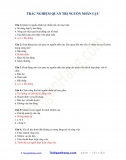Merge and acquisition basics (Mua bán - Sáp nhập cơ bản)
MERGER AND ACQUISITION BASICS
by
Hutchison +Mason PLLC
November 2001
The acquisition of a business may be structured in a variety of ways, including, an asset sale, a stock sale, or a merger. The structure of the acquisition will be determined by a variety of accounting, business, legal, and tax considerations. Regardless of the structure of the transaction, acquisition agreements have the following four common and very important features which are examined in this article: (a) representations and warranties; (b) pre -closing covenants; (c) conditions precedent to closing; and (d) indemnification.
Representations and Warranties
The seller and the buyer will make representations and warranties to the other in the acquisition agreement. The seller’s representations and warranties typically make up the largest part of the acquisition agreement. Representations and warranties serve three important purposes. First, they are informational. The seller’s representations and warranties, coupled with the buyer’s due diligence, enable the buyer to learn as much as possible about the seller’s business prior to signing the definitive acquisition agreement.
Second, theyare protective. The seller’s representations and warrant ies provide a mechanism for the buyer to walk away from, or possibly to renegotiate the terms of, the acquisition, if the buyer discovers facts that are contrary to the representations and warranties between the signing and the closing. Third, they are supportive. The seller’s representations and warranties provide the framework for the seller’s indemnification obligations to the buyer after the closing.
Prior to signing the acquisition agreement, the buyer will want to learn as much as possible about the seller’s business. Therefore, the buyer will require the seller to make extensive representations and warranties about its business. Many of these representations and warranties will be specific to the seller’s industry. However, the most common representations and warranties include: (a) corporate organization, authority, and capitalization; (b) assets; (c) liabilit ies; (d) financial statements; (e) taxes; (f) contracts, leases, and other commitments; (g) employment matters; (h) compliance with laws and litigat ion; (i) product liabil ity; and (j) environmental protection.
From the seller’s perspective, if the buyer is paying the purchase price in cash at the closing, the most important representations and warranties the seller can elicit from the buyer are those governing the buyer’s corporate authorization and financial condition (i.e., the buyer’s ability to paythe purchase price). If the buyer is paying the purchase price over time or by issuing stock, the seller will require more extensive representations and warranties from the buyer.
ThiNganHang.com


 ThiNganHang Sách - Tài liệu thi tuyển
ThiNganHang Sách - Tài liệu thi tuyển









